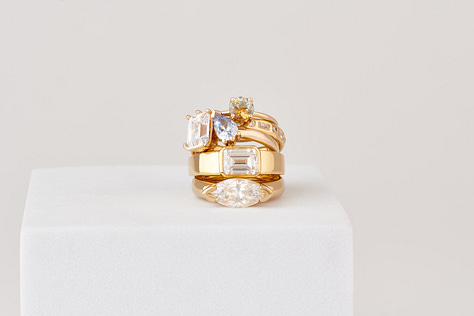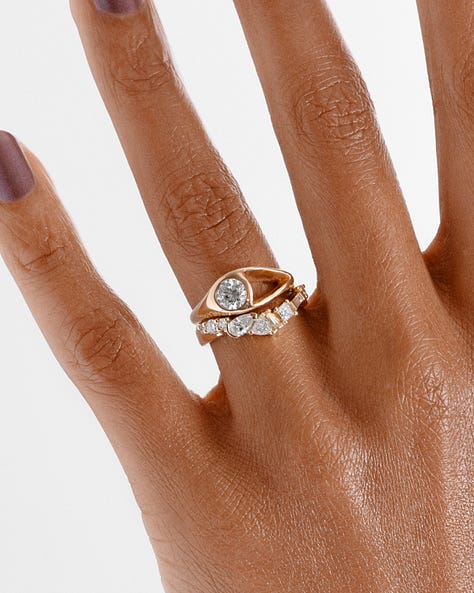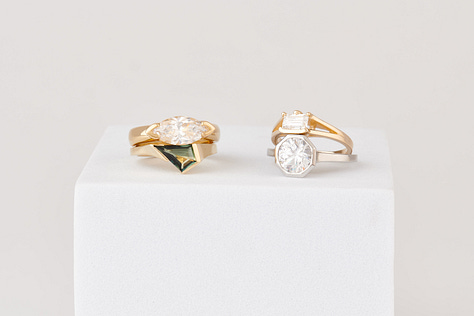Take Five with Page Neal
Get familiar with one of ethically sourced jeweler Bario Neal's founders
This issue is posted in collaboration with the lovely team at Bario Neal. I have an affiliate link shared below, meaning I would earn a percentage of sales purchased via the link. I want to be fully transparent: this is a special opportunity to work with a brand I really believe in, who is making a positive impact in the jewelry industry, and in turn believes in my work. I hope you enjoy learning about Bario Neal today!!!
Anna Bario and Page Neal founded Bario Neal in 2008 out of an interest in including sustainability discourse and social impact into fine jewelry and gemstone sourcing. Founded in Philly, tradition is a present theme across their communications: the impact of heritage, of storytelling, creating or continuing. Their beautiful, sculptural craftmanship is bolstered by the steadfast transparency and high standards of both artisanal mining and lab grown diamonds. Press mentions include Forbes, into the gloss, The New York Times and Vogue.
As many sustainably-minded independent brands can attest, it’s no small feat to execute stringent environmental responsibility at its genesis. Across any industry! Mined diamonds come at the price of deforestation, land clearance, habitat destruction, and greenhouse gas emissions. To be carbon neutral in a carbon intensive industry is proof that Bario Neal is creating a new blueprint for the future of jewelery. In 2013, Bario Neal was one of the first stakeholders of Fairmined Gold, which is now available in Fairmined Silver, supporting people and local economies that have been devastated traditionally from large scale mining.
I always tell people my work in fashion, wellness, and the food & beverage industries has trained me to have more of an eagle eye on ingredients and material sourcing, and what I enjoyed the most about this interview was picking Page’s brain and finding so many gems that I didn’t have any knowledge about previously. I hope you find something to learn and look out for the next time you frost yourself !
How have you been able to define the ethical, earth-conscious fine jewelry industry through your business?
At our core, we believe that fine jewelry should not only be beautiful but also ethically sourced and environmentally sustainable. Since our inception sixteen years ago, Anna and I have been fascinated with researching the people and places our most precious items pass through. We knew that within our own business, we wanted to do things differently and prioritize transparency and responsibility in every aspect — from mine to market.
From the materials we choose like heirloom stones and recycled metals to handcrafting every piece in-house, to our rigorous supplier evaluation processes aligned with the United Nations’ Sustainable Development Goals, and even the way we decorate our stores — we wanted to honor the beauty of what already exists and create pathways to minimize our impact on the earth. By building a company with intention from the very beginning, we embrace the challenges that come with upholding our values, even when it costs us more. We believe it is essential to set a positive example for the industry at large, demonstrating that ethical practices and sustainability can coexist with fine craftsmanship and artistry.
What does the modern day Bario Neal engagement ring look like?
We believe that jewelry holds the power to tell stories, celebrate life’s most cherished moments, and honor traditions, and there’s perhaps no piece more meaningful than an engagement ring. It’s a true privilege for us to craft these special heirlooms, which often become treasured symbols passed down through generations. More and more, we see couples designing their rings together — creating a shared story and ensuring each piece complements the other, reflecting the unique bond they’ve built. From the outset, we have sought to redefine the traditional norms of the jewelry industry by celebrating all identities and forms of love. The right to love who you choose is one of our founding beliefs, displayed by our gender-neutral and size-inclusive design ethos.
We believe it is essential to set a positive example for the industry at large, demonstrating that ethical practices and sustainability can coexist with fine craftsmanship and artistry.
One of your key services is heirloom redesign. Can you provide details of this process, and what it means for circular business in this industry?
Heirloom redesign is one of our most meaningful services because it allows clients to breathe new life into pieces that hold personal or family history. Our process begins with understanding the story behind each piece, often connecting with clients on the sentimental value tied to the materials or design. We evaluate the original elements — whether heirloom stones, vintage metalwork, or unique design motifs — and work closely with clients to reimagine these components into pieces that honor the past while fitting seamlessly into their present-day lives. This could mean resetting stones, melting down metals, or combining multiple pieces into one cohesive design that feels both familiar and fresh.
Heirloom redesign aligns with our commitment to circularity and sustainability within the jewelry industry. Rather than sourcing new materials, we celebrate what already exists, reducing the demand for newly mined resources and mitigating environmental impact. Through this process, we not only preserve the materials but also the emotional significance of each piece, transforming memories into wearable art that can continue to be cherished.
Many of your diamonds are sourced from Australia and Canada, who are known for their rigorous standards. What can you tell us about what sets these countries (and their regulations) apart?
Australia and Canada have become key sources for our diamonds because of their commitment to stringent environmental and ethical standards. Both countries have established mining regulations that are some of the strictest in the world, prioritizing sustainable practices, transparency, and respect for local communities.
In Australia, mines like the Argyle Diamond Mine are required to follow rigorous guidelines for environmental management, which include land rehabilitation, wildlife conservation, and minimizing their impact on local ecosystems. Canadian diamonds, similarly, come from operations in remote regions that are highly regulated, with oversight ensuring that Indigenous communities benefit economically from the mining projects and that their lands are respected. Canada’s “CanadaMark” certification, for example, verifies that a diamond has been mined in an environmentally conscious manner and meets strict labor standards. Both countries have led the industry in accountability, making it possible for us to offer our clients diamonds that align with our values of sustainability and ethical sourcing.



What have you found most important in the education and awareness of ethical jewelry for consumers?
We believe that providing clear information about sourcing practices, materials, and the impact of their choices empowers consumers to make informed decisions. But probably the most important component is meeting customers where they are in their understanding. We recognize that some consumers prefer a high-level overview, while others seek in-depth information. To accommodate this, we provide both extremely detailed resources like our sustainability reports, as well as straightforward information for customers to grasp the essentials without overwhelming them. This dual approach ensures that all customers can engage with our brand in a way that aligns with their interests and knowledge levels, promoting a more inclusive dialogue about sustainability in the jewelry industry.
As a female-founded business, have you found local communities or businesses to support in your brand journey?
Absolutely. We always prioritize supporting local artisans and businesses within our community. We learned so much from the skilled craftspeople of Philadelphia’s historic Jeweler’s Row, so it only feels right to give back and continue to invigorate our community of artisans when possible. We actually just debuted a special collaboration with an iconic pillar of the city, The Rittenhouse Hotel. Together, we designed an heirloom locket that celebrates the city’s past, present, and future with a commitment to excellence, sustainability, and the preservation of Philadelphia’s unique spirit.
Which piece of jewelry in your personal collection has the most sentimental story?
I actually designed our Shield Lapis Slice Pendant during my pregnancy with my first child, Miles. I wanted to create something meaningful that could guide me through labor and the postpartum journey, and to this day, this talisman represents unconditional love and protection. It serves as a tangible connection between me and my son, and I loved it so much that when my daughter Ila was born three years later, I continued this tradition. Plus, it’s a piece that inspired our new collection debuting later this month, so I’m really excited about that.
PAGE’S FIVE FAVES
I love vintage clothing and furniture — and hunting for it!
My old cruiser bike is another favorite. I try to ride it whenever I can.
My local farmer’s market lets me bring nourishing food into my kitchen each week, and I’m really grateful for that.
My local library — and libraries in general — are beautiful, inspiring places that truly have the whole circularity initiative down!
The compost business that picks up our compost each week. Food waste can be a byproduct of having kids, and this makes me feel a little bit better about it.
IG @barioneal
Find out more about Bario Neal onsite.
ICYMI
It's Not Office Siren - It's Fourth Wave Feminism
Ahead of the election, Mugler's iconic silhouette symbolized where the feminist movement has begun to mirror that of the 80s.







